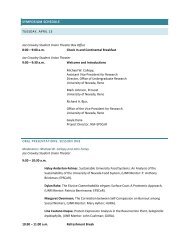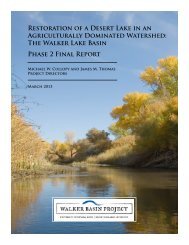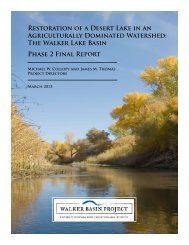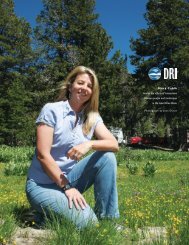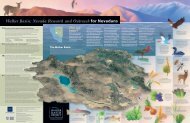Student Research Programs - Office of Undergraduate and ...
Student Research Programs - Office of Undergraduate and ...
Student Research Programs - Office of Undergraduate and ...
Create successful ePaper yourself
Turn your PDF publications into a flip-book with our unique Google optimized e-Paper software.
activity <strong>and</strong> PGE2 levels, while DHA may be having inhibitory effects on cancer cell growth by decreasing activated<br />
COX.<br />
EXPRESSION OF POLY-ADENYLATED NUCLEAR RNA ELEMENT IN KAPOSI’S SARCOMA ASSOCIATED<br />
HERPES VIRUS USING LENTIVIRUS<br />
Nana Matsumoto<br />
Program: NIH INBRE<br />
Mentors: Cyprian Rossetto, Gregory Pari<br />
Department: Biochemistry <strong>and</strong> Molecular Biology<br />
University <strong>of</strong> Nevada, Reno<br />
Kaposi’s Sarcoma Herpes Virus (KSHV) is a large gammaherpesvirus, which is<br />
known to be a causative agent for Kaposi’s sarcoma (AIDS associated cancer),<br />
primary effusion lymphoma (PEL), <strong>and</strong> multicentric Castlemen’s disease (MCL).<br />
Therefore, deciphering the virus’ mechanism <strong>of</strong> replication <strong>and</strong> its interactions with<br />
the host cell is <strong>of</strong> great interest. One notable lytic transcript produced by KSHV <strong>of</strong><br />
our interest is PAN (poly-adenlyated nuclear transcript). PAN (1077bp in length) is<br />
an exclusively nuclear, unspliced, non-coding RNA that becomes the most<br />
abundant transcript within the host cell’s nucleus during lytic infection (~70-80% <strong>of</strong> total transcript). To date, no<br />
known function <strong>of</strong> PAN is observed. The two objectives <strong>of</strong> this study were to: first, successfully clone PAN into a<br />
vector compatible with lentiviral expression system, <strong>and</strong> second, obtain viral titers expressing PAN-RNA to<br />
transduce target cells in the future. This system allows observing the cellular effects from PAN without any<br />
interruptions via other viral components <strong>of</strong> KSHV, <strong>and</strong> ensures transfection <strong>of</strong> a wide spectrum <strong>of</strong> cells – thus<br />
creating a better model that mimics natural infection. To meet the objectives, the PAN locus was PCR amplified<br />
<strong>and</strong> cloned into an expression vector containing the lentivirus genome <strong>and</strong> antibiotic resistance necessary for<br />
selection. The vector, along with other components <strong>of</strong> the lentivirus genome were cotransfected into human<br />
embryonic kidney (HEK) 293FT cells where lentiviral titers were confirmed. After conducting antibiotic selection<br />
with HEK 293L cells followed by RT-PCR, we confirmed that PAN-RNA was indeed being produced in the target<br />
cells. This suggests that we will now be able to transduce various cell lines with PAN. Future studies will focus on<br />
the precise role <strong>of</strong> PAN <strong>and</strong> its potential roles in inhibiting the host’s innate immunity.<br />
DETERMINATION OF A SORPTION MECHANISM FOR 17B-TRENBOLONE<br />
Samantha McBride<br />
Program: NSF EPSCoR<br />
Mentors: Edward Kolodziej<br />
Department: Civil <strong>and</strong> Environmental Engineering<br />
University <strong>of</strong> Nevada, Reno<br />
Trenbolone acetate is frequently injected into cattle as a growth promoter in the<br />
beef industry. Once injected, it metabolizes to its most active form, the 17β isomer.<br />
After trenbolone (TB) makes its way through the body, it is excreted as a<br />
combination <strong>of</strong> 17β, 17α, <strong>and</strong> trendione. These metabolites <strong>of</strong>ten enter natural<br />
waters via rainfall run-<strong>of</strong>f, <strong>and</strong> have the potential to enter our water supply. Both<br />
case studies <strong>and</strong> extensive research have shown that TB acts as an endocrine<br />
disruptor in fish, causing trans-genderization. As a result, the potential impact on<br />
human health if these steroids were to enter our water supply is <strong>of</strong> concern. My project therefore focused on<br />
developing a deeper underst<strong>and</strong>ing <strong>of</strong> how 17β-TB moves throughout the environment. Previous research has<br />
16



